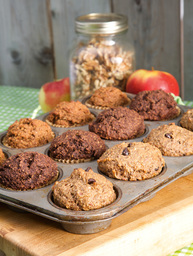 With the new school year just around the corner, it's time to start thinking about school lunches again. Here are some great tips from OHEA member Mairlyn Smith, P.H.Ec Tips for Packing Healthy lunches: 1. Choose a lunch that includes whole grains, lean protein, vegetables and fruit, and foods that contain calcium like dairy foods.
2. Tuck in a healthy treat such as a homemade muffin using whole grains. Try baking mini muffins for mini appetites. Many children like/need a snack at recess. When you bake a batch of muffins, wrap some individually and freeze them for quick lunch additions, or buy ready-made low-fat muffins such as bran or oatmeal and raisin. 3. Provide plenty to drink. Students who are dehydrated lose their ability to think and learn and can often be very distracted. Pack two or three drinks, if possible. Make it water for snacks and milk or a milk substitute for their lunch. (Tip: if using rice, nut or soy beverages as a milk substitute make sure you teach your kids to shake the container before they open it, the calcium that is added tends to stick to the bottom of the container) 4. Add lots of variety, so that lunches do not become predictable and boring. 5. Keep cold foods cold and hot food hot for safety. Use an insulated lunch bag with frozen 100% juice, milk or milk substitutes in Tetra Pak® containers to keep it cold. A wide-mouth thermos will hold a hot soup until lunch. Keep an assortment of baggies on hand for ease of wrapping. 6. Watch for school rules regarding the use of peanut butter due to allergies. 7. Avoid too many sweets and high fat foods as they add calories but often little food value. A child can experience fatigue sooner when a diet is too high in sugar. When packing juice, make sure it is 100% juice and only one serving of juice per day. 8. Make your own "trail mix" with dried cranberries, raisins or other dried fruits, and just a few mini chocolate chips or mini M&M’s for a hint of chocolate OR buy an already prepared mix and add some of the above favourites. Use the snack-size zip locks to tuck in this fibre-rich treat. Double-Chocolate Pumpkin Muffins Excerpted from Healthy Starts Here!, by Mairlyn Smith. Reprinted with permission of Whitecap Books, 2011 Next time you have to send a treat to school, pack up these muffins and tell your kids they’re chocolate cupcakes — they taste that good. Sometimes when you tell a kid there’s pumpkin in something they just won’t eat it, so I give you permission to omit that minor detail. (If you’re sending these muffins to school, check the chocolate chips’ label for any mention of peanuts, in case of allergies.) Makes 12 muffins | One serving = 1 muffin Ingredients 1 cup (250 mL) packed dark brown sugar 1 cup (250 mL) buttermilk 1 cup (250 mL) pure pumpkin purée (not pumpkin-pie filling; see page 16) 1/2 cup (125 mL) oat bran 1 omega-3 egg (see page 13) 1 cup (250 mL) whole wheat flour 3/4 cup (185 mL) ground flaxseed (see page 13) 1/2 cup (125 mL) natural cocoa powder (see page 12) 1/4 cup (60 mL) chocolate chips with at least 60% cocoa mass or chocolate chunks with at least 70% cocoa mass 2 tbsp (30 mL) wheat germ 2 tbsp (30 mL) cinnamon 1 1/2 tsp (7.5 mL) baking powder 1 tsp (5 mL) baking soda Preheat the oven to 400°F (200°C). Line a 12-cup muffin pan with paper liners. Whisk together the brown sugar, buttermilk, pumpkin, oat bran, and egg in a medium bowl. Set aside. Whisk together the flour, flaxseed, cocoa, chocolate chips, wheat germ, cinnamon, baking powder, and baking soda in a large bowl. Add the sugar / pumpkin mixture to the flour mixture and mix until just combined. Divide the batter evenly among the muffin cups (I use a 1/4-cup / 60 mL ice-cream scoop with a release lever). Bake until a toothpick comes out clean, 20 to 25 minutes. Let the muffins cool in the pan on a wire rack for 5 minutes. Remove the muffins and let them cool completely on the wire rack. (Store the muffins in an airtight container for up to 2 days, or freeze for up to 2 months.) Per muffin: 190 calories, 4.6 g total fat, 1 g saturated fat, 0 g trans fat, 183 mg sodium, 35.6 g carbohydrate, 5 g fibre, 18.4 g sugars, 5 g protein Diabetes Food Choice Values per muffin: 2 Carbohydrate, 1 Fat Pumpkin 101 Aside from making scary jacko’-lanterns, pumpkins are a storehouse of nutrients, but only the ones that are too small for lanterns are good for eating.
1 Comment
|
The Ontario Home Economics Association, a self-regulating body of professional Home Economists, promotes high professional standards among its members so that they may assist families and individuals to achieve and maintain a desirable quality of life. Categories
All
Archives
April 2024
|
|
Subscribe to our mailing list
|
|
Unsubscribe from our mailing list
|
Copyright © 2023 Ontario Home Economics Association (OHEA). All Rights Reserved.


 RSS Feed
RSS Feed